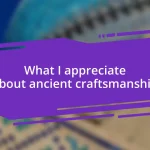Key takeaways:
- Lampworking has a rich historical significance, originating in ancient Rome and evolving through various cultural periods, reflecting the artistry and craftsmanship of each era.
- Key techniques in lampworking, such as marvering and encasing, foster creativity and enhance the emotional connection to the craft.
- Modern lampworking applications include functional art, jewelry design, and mixed media, showcasing the versatility and evolving nature of the craft.

Introduction to lampworking archives
As I first delved into the world of lampworking archives, I was struck by the sheer depth of history encapsulated within them. It’s fascinating how each bead or glass piece has a story to tell, connecting artists and enthusiasts across generations. Have you ever wondered what secrets lie within the intricate patterns of these glassworks?
While browsing through these archives, I found my heart racing at the discovery of old techniques that seemed almost magical. It reminded me of the first time I successfully shaped a piece of glass; there’s something profoundly satisfying about seeing the tangible results of patience and skill. I often reflect on the emotions these archives evoke—curiosity, joy, and even nostalgia for a craft that has woven through so many lives.
I often think about how lampworking isn’t just about creating beautiful objects; it’s also about the traditions and inspirations passed down through the years. I believe that the archives serve as a bridge to those rich histories, offering us a chance to learn and innovate while honoring the past. Isn’t it amazing how glass can unify art and history in such an engaging way?

Historical significance of lampworking
Lampworking has a historical significance that stretches back centuries, reflecting the evolution of craftsmanship and artistry. In my exploration, I discovered that lampworking originated in the ancient Roman era, where artisans crafted glass beads for adornment. This practice wasn’t merely an artistic outlet; it served as a vital trade, showing how cultures across the globe embraced glass in their daily lives. Have you ever thought about the connections formed through these tiny beads? Each one tells a story of trade routes, cultural exchanges, and personal histories.
As I dug deeper into the lampworking archives, I couldn’t help but feel a connection to the artisans who came before me. The meticulous techniques they employed, such as the use of flame and rod to shape glass, reveal a shared lineage of creativity. I vividly remember the moment I learned to control the flame; it felt like stepping into the shoes of those ancient artists, a rite of passage that linked me to a legacy. Their innovations, like the development of colored glass, revolutionized the craft, showcasing how changing technologies can influence artistic expression over time.
Moreover, I found that lampworking has been a medium for social and cultural dialogue. Historically, these glass creations often reflected the societal values and aesthetics of their time. Interestingly, by examining the patterns and styles of different periods, I realized how closely they mirror the cultural shifts within society. Isn’t it powerful to think of lampworking as more than just an art form—it’s a window into history itself, articulating human experiences through glass?
| Historical Period | Significance of Lampworking |
|---|---|
| Ancient Rome | Beginning of glass bead making; a trade essential. |
| Middle Ages | Refinement of techniques and introduction of decorative glass. |
| Renaissance | Explosion of glass art, leading to innovations in technique and style. |

Key techniques in lampworking
Lampworking techniques are as captivating as the finished pieces themselves, each demanding a unique skill set and a deep understanding of materials. I distinctly remember the first time I tried “stringer work,” where I learned to pull thin strands of glass to create detailed designs. The focus required to control the width and consistency of each string was both exhilarating and nerve-wracking. When the design finally came together, it felt like orchestrating a delicate dance between heat and glass, a moment I’ll never forget.
Here are some key techniques in lampworking that have shaped the craft:
- Marvering: This involves rolling hot glass on a smooth surface to shape it and remove air bubbles.
- Paddle Technique: Using a flat tool to flatten and shape molten glass, creating unique forms.
- Encasing: Layering clear glass over colored glass to enhance depth and create stunning visual effects.
- Reduction: This technique is all about manipulating the flame to alter the surface of the glass, bringing out metallic finishes.
Each technique opens a door to endless creativity, and I often find myself reflecting on the emotions tied to these processes—frustration, joy, and that indescribable thrill when something truly beautiful emerges from the flame. Just thinking about that journey inspires me to keep experimenting and learning, turning lessons from the archives into my personal evolution as a lampworker.

Notable lampworking artists and styles
Lampworking is a fascinating space filled with diverse styles and remarkable artists who have pushed the boundaries of what can be achieved with glass. One artist that particularly resonates with me is T. H. Wong, known for his intricate sculptures that seem to breathe life into glass. I remember first seeing his work; the delicate features and vibrant colors captured my imagination, making me realize how the medium can convey emotion. Have you ever seen a piece that just took your breath away? Wong’s creations not only stand out aesthetically but also inspire countless lampworkers, pushing them to explore deeper narratives through their art.
Then there’s the distinct Venetian style, which has a rich legacy dating back to the Renaissance. I find myself drawn to how this style emphasizes intricate patterns and vibrant colors, reflecting the artistry and craftsmanship of the period. While working on my projects, I often think about how these historical influences shape my own designs. It’s challenging to replicate those fine details, but each attempt teaches me something new about patience and precision. Wouldn’t it be exciting to imagine the collective impact of these artists, each contributing to a broader conversation about beauty and expression in glass?
Additionally, modern lampworking has introduced innovations that are just as stimulating as traditional styles. Artists like Jennifer Squires, who cleverly blend techniques from various cultures, truly exemplify how lampworking evolves. I enjoy experimenting with colors and shapes influenced by contemporary artists as it allows me to break free from convention. It’s these moments of exploration and creativity that not only improve my skills but also deepen my connection to the global lampworking community. In what ways has learning about different styles inspired you to create something unique?

Preservation and curation of lampworking
The preservation and curation of lampworking is essential to ensure that the techniques and artistry of this craft are not lost to time. I recall visiting a dedicated lampworking museum where I marveled at the meticulous care taken to display historical pieces. Each lampwork creation was accompanied by informative plaques detailing its background, revealing the stories and pioneering artists behind it. Isn’t it fascinating how the right curation can bring a piece to life, allowing us to witness the evolution of this beautiful art form?
Additionally, archives play a crucial role in preserving the knowledge and techniques that define lampworking. I often find myself diving into historical documents, where I’ve discovered gems of information about forgotten methods and approaches. One particular document outlined the “lost” techniques of early lampworkers, igniting my curiosity to experiment and revive these practices in my own work. It raises an interesting question: how many techniques remain hidden, waiting to be rediscovered by eager hands in contemporary studios?
Furthermore, the community’s dedication to sharing knowledge underlines the importance of collaboration in lampworking. I remember joining a workshop that emphasized the importance of documenting personal experiments and sharing them with fellow artists. This sense of collective preservation ensures that innovations and traditional techniques coexist, weaving a richer narrative for future generations. Reflecting on this, how can we each contribute to the ongoing story of lampworking, ensuring that our unique experiences and insights are part of this beautiful tapestry?

Modern applications of lampworking skills
The modern applications of lampworking skills are as varied as they are exciting. I’ve noticed that many lampworkers are now incorporating their glass creations into functional art. For instance, I once saw a stunning series of lampworked wine glasses that not only showcased vibrant colors but also had unique shapes that sparked conversation at dinner parties. Have you ever considered how beautiful utility can blend seamlessly with artistry?
Moreover, I’ve observed that lampworking techniques are finding their way into jewelry design. I remember crafting a pair of earrings that featured delicate lampworked beads; wearing them felt like showcasing a tiny piece of my creativity. This intersection of wearable art allows lampworkers to express themselves in everyday settings, bringing their artistry into the lives of others. Doesn’t it feel rewarding to know that our creations can be not just admired but also worn and cherished?
Another fascinating trend is the incorporation of lampworking in mixed media art. I’ve experimented by fusing my glass pieces with photography and painting, creating unique narratives that challenge traditional boundaries. For me, this cross-pollination enhances both my skills and perspectives. How do you see lampworking evolving in your own artistic journey?














